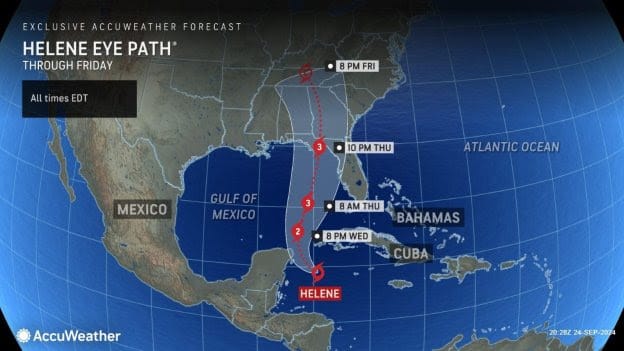
AccuWeather Global Weather Center – Sept. 24, 2024 – AccuWeather expert meteorologists say people along the upper Gulf Coast region of Florida have less than 48 hours to prepare for life-threatening storm surge, destructive winds, flooding and spin-up tornadoes embedded in tropical rainbands.

“We’re urging people to get away from the immediate coastline and follow evacuation orders by local officials. We’re expecting deadly storm surge in parts of the Big Bend region. If you get caught in this storm surge in the hardest-hit areas, rescue crews likely will not be able to respond during the height of the storm. It’s too dangerous,” warned AccuWeather Lead Hurricane Expert Alex DaSilva. “This hurricane is expected to be quite large. Impacts will be widespread.”
Helene was officially named a tropical storm on Tuesday morning. AccuWeather was the first known source to issue a track and intensity forecast on Sunday afternoon.
“This is another classic case of homegrown development. We have less than 72 hours between the point when the developing storm is officially named and when it makes landfall as a powerful hurricane,” said AccuWeather Chief On-Air Meteorologist Bernie Rayno. “Homegrown development leaves people with less time to prepare. These water temperatures are high octane, it’s like pouring gasoline on a fire.”
AccuWeather Chief Meteorologist Jon Porter says exceptionally warm water temperatures and other conducive factors will allow Helene to rapidly intensify over the next 24 hours.

“Water temperatures are 4 to 6 degrees warmer than the historic average in many parts of the Gulf. There are some pockets with record-shattering temperatures right now,” said Porter. “Helene is forecasted to track right through areas with the warmest water temperatures in the Atlantic basin reaching hundreds of feet below the surface. Rapidly intensifying hurricanes can bring greater impacts at landfall. That’s why we’re so concerned about storm surge.”
AccuWeather expert meteorologists will closely monitor the timing of the tides as Helene approaches the coast before making landfall on Thursday.
“A bit of good news is we expect to be at low astronomical tide around landfall. We’re not dealing with a full moon or a new moon. That would make the situation worse,” DaSilva explained. “The storm is going to be picking up speed as it interacts with that dip in the jet stream. At least initially, it’s going to be moving pretty fast. That will allow stronger winds to reach farther inland compared to a slower-moving storm. The storm will eventually slow down or even stall out over the Tennessee Valley.”
AccuWeather expert meteorologists are forecasting wind gusts to reach 120-130 mph with an AccuWeather Local StormMax™ of 160 mph near the area where the center of circulation makes landfall.

Gusty winds of 40-60 mph can extend north across much of the Southeast as the storm moves north on Friday, then into the southern Appalachians and Tennessee River Valley on Saturday. This wind, combined with the rain, can bring down trees and power lines.
Rainfall totals of 4-8 inches can extend across the Florida Panhandle and into the western Carolinas and eastern Alabama. Near where the center makes landfall, rainfall totals can reach 8-12 inches with an AccuWeather Local StormMax™ of 24 inches. This heavy rain can lead to widespread flooding near the center of the storm. With the speed of the storm, the rain will come down fast and furious, overpower drainage systems, leaving a significant risk for life-threatening flooding over a widespread area.

“Helene could cause a flooding disaster in some areas of the Southeast, especially in the higher terrain of northern Georgia, upstate South Carolina and western North Carolina. This is due to the combination of rain ahead of Helene on Wednesday and Wednesday night and then another thrust of torrential rain Thursday and Thursday night as Helene moves inland,” said Porter. “In this area, 8-12 inches of rain can occur, with the heaviest coming within only a few hours when the rainfall rate can exceed 2 inches per hour, which is enough to cause significant and life-threatening flooding. The risk is greatest in the steep terrain of the Southern Appalachians, where mudslides and rockslides can occur. Some communities may be cut off with no way to enter or exit if there is damage to infrastructure such as bridges and roadways. Areas of significant urban flash flooding may also occur in the Atlanta metropolitan area should rain rates exceed 2 inches per hour, which can result in rapidly rising water and life-threatening flash flooding.”
AccuWeather expert meteorologists say the risk of extreme rainfall rates in the Big Bend region of Florida extends beyond the Tallahassee region into southeastern Georgia. There is also a high risk of flash flooding in northeast Georgia, western North Carolina, eastern Tennessee and southwestern Virginia.

“The inland flooding threat can sometimes be overlooked and unfortunately that can cause the highest amount of fatalities after a hurricane landfall. This threat is amplified because we’re expecting heavy rainfall from Atlanta through the southern Appalachians long before the impacts from Helene arrive,” said AccuWeather Senior Director of Forecasting Operations Dan DePodwin. “There could be a flooding disaster in several areas because of the extreme rainfall rates and what will likely be record rainfall for the Southeast in September.”
A dangerous storm surge of 6-10 feet is expected from north of Tampa Bay, westward to east of Apalachicola. A life-threatening and devastating storm surge of 10-15 feet is expected just east of the Big Bend region of Florida, near where the rainstorm makes landfall.

There will be a threat of tornadoes as Helene moves up the coastline and makes landfall on Thursday and continues northward Friday, mainly north and east of the track of the center of the storm. Tornadoes from tropical systems can occur at night and form very quickly without warning.

AccuWeather expert meteorologists say there is an extreme risk to lives and property along the Big Bend region of Florida. There is widespread risk of power outages in the Tallahassee region. The risk of regional and localized power outages extends as far north as southwest Virginia.
Major travel disruptions are expected throughout the Southeast. AccuWeather is forecasting 750 flight cancelations on Thursday, 1,300 flight cancelations on Friday, and 500 flight cancelations on Saturday.

Due to impacts from dangerous flooding rainfall, strong winds and storm surge and the total damage and economic impact this storm is expected to bring, this wind and rainstorm is a 3 for United States on the AccuWeather RealImpact™ Scale for Hurricanes, which warns of widespread and substantial flooding, structural damage to buildings, especially mobile homes, as well as downed trees, power outages and major coastal inundation.

In contrast to the Saffir-Simpson scale, which classifies storms by wind speed only, the AccuWeather RealImpact™ Scale is based on a broad range of important factors. In order to better communicate a more comprehensive representation of the potential impact of a storm on lives and livelihoods, the scale covers not only wind speed but also flooding rain, storm surge and economic damage and loss. Some of these hazards, such as inland flooding and storm surge in many storms, result in more deaths and economic loss than wind.
Advertise with the mоѕt vіѕіtеd nеwѕ ѕіtе іn Antigua!
We offer fully customizable and flexible digital marketing packages.
Contact us at [email protected]


















Cat 4 storm because winds at *flight level* are *forecast* to top 105 mph.
Question: how many people live at 2500 to 5000 feet MSL? More “climate change” bullshit in this forecast?
Comments are closed.